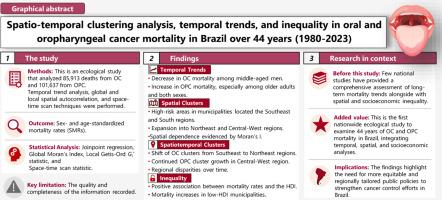Spatio-temporal clustering analysis, temporal trends, and inequality in oral and oropharyngeal cancer mortality in Brazil over 44 years (1980–2023)
IF 1.7
Q3 PUBLIC, ENVIRONMENTAL & OCCUPATIONAL HEALTH
引用次数: 0
Abstract
This study analyzed the temporal trends, spatial and spatio-temporal patterns of OC and OPC mortality in Brazil between 1980 and 2023, and explored their association with socioeconomic inequality. We conducted an ecological study using age- and sex-standardized mortality rates, smoothed via a local empirical Bayesian method. We assessed temporal trends through joinpoint regression. We evaluated global and local spatial autocorrelation and detected spatio-temporal clusters using a retrospective space–time scan statistic based on a Poisson model. We observed a decrease in OC mortality, particularly among men aged 40–59 years in the Southeast and South regions. In contrast, OPC mortality increased throughout the study period in both sexes, especially among individuals aged 60–79 years, with the largest increases occurring in the North, Northeast, and Central-West regions. Moran’s I revealed significant spatial dependence for both cancers. Spatial analyses identified persistent high-risk clusters in the Southeast and South, which expanded toward the Northeast and Central-West. Spatio-temporal analysis showed a recent shift of major OC clusters from the Southeast and South towards the Northeast, whereas OPC clusters continued to expand into the Central-West. Municipalities within clusters characterized by a low Human Development Index exhibited comparatively stronger increases in mortality trends for both cancers. These results underscore the need for more equitable and regionally tailored public policies to strengthen cancer control efforts in Brazil.

巴西44年(1980-2023年)口腔癌和口咽癌死亡率的时空聚类分析、时间趋势和不平等
本研究分析了1980 - 2023年巴西地区OC和OPC死亡率的时间趋势、空间和时空格局,并探讨了其与社会经济不平等的关系。我们使用年龄和性别标准化死亡率进行了一项生态研究,并通过当地经验贝叶斯方法进行了平滑。我们通过连接点回归评估了时间趋势。我们评估了全局和局部空间自相关性,并使用基于泊松模型的回顾性时空扫描统计来检测时空集群。我们观察到OC死亡率下降,特别是在东南部和南部地区40-59岁的男性中。相比之下,在整个研究期间,男女OPC死亡率均有所上升,尤其是60-79岁的人群,北部、东北部和中西部地区的增幅最大。莫兰的I显示了两种癌症的显著的空间依赖性。空间分析表明,东南部和南部持续存在高风险集群,并向东北部和中西部扩展。时空分析表明,近年来,主要的温带植物集聚区由东南和南部向东北方向转移,而温带植物集聚区继续向中西部扩展。在人类发展指数较低的集群内的城市,两种癌症的死亡率增长趋势相对较强。这些结果强调需要制定更公平和适合区域的公共政策,以加强巴西的癌症控制工作。
本文章由计算机程序翻译,如有差异,请以英文原文为准。
求助全文
约1分钟内获得全文
求助全文
来源期刊

Spatial and Spatio-Temporal Epidemiology
PUBLIC, ENVIRONMENTAL & OCCUPATIONAL HEALTH-
CiteScore
5.10
自引率
8.80%
发文量
63
 求助内容:
求助内容: 应助结果提醒方式:
应助结果提醒方式:


